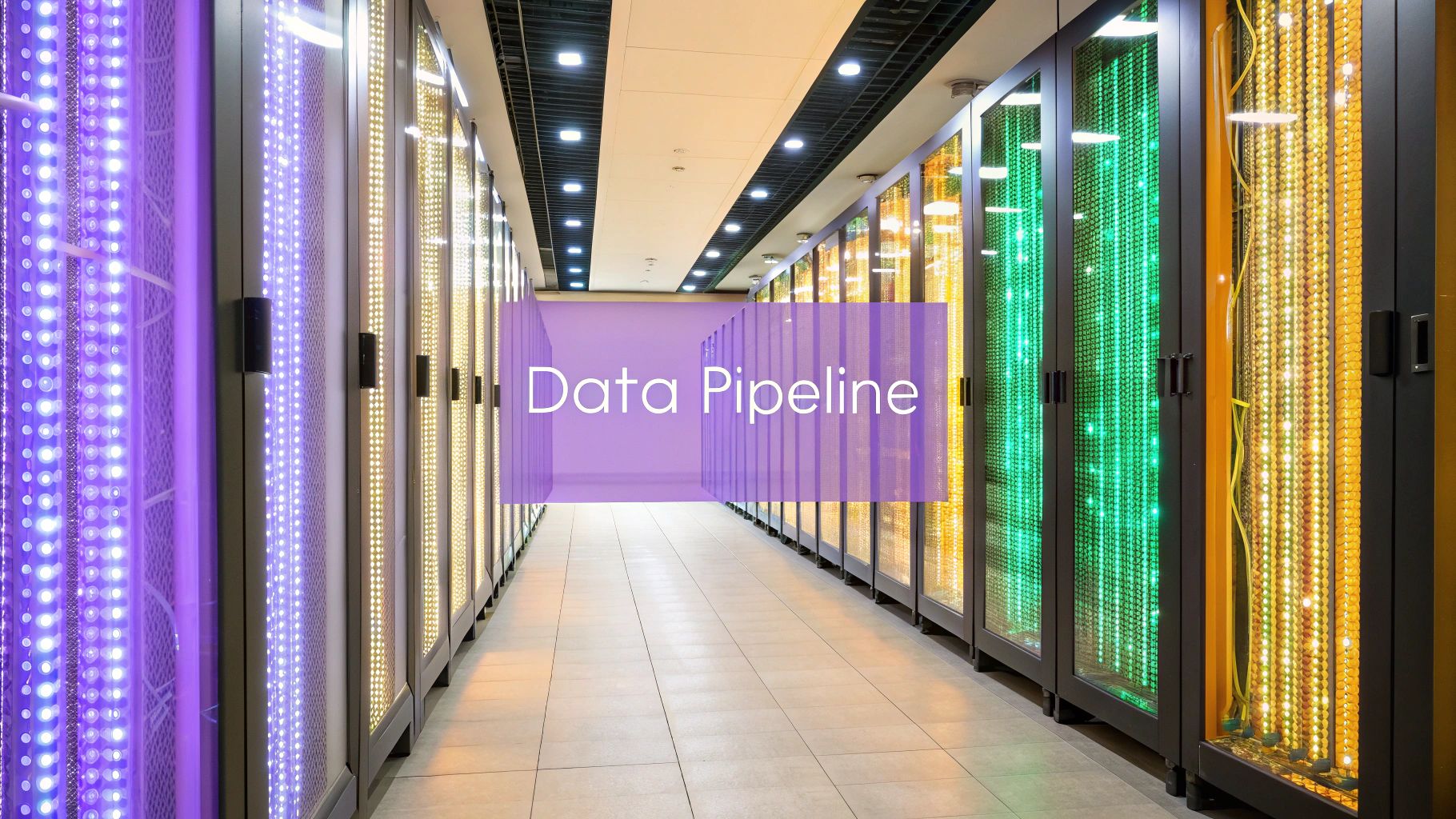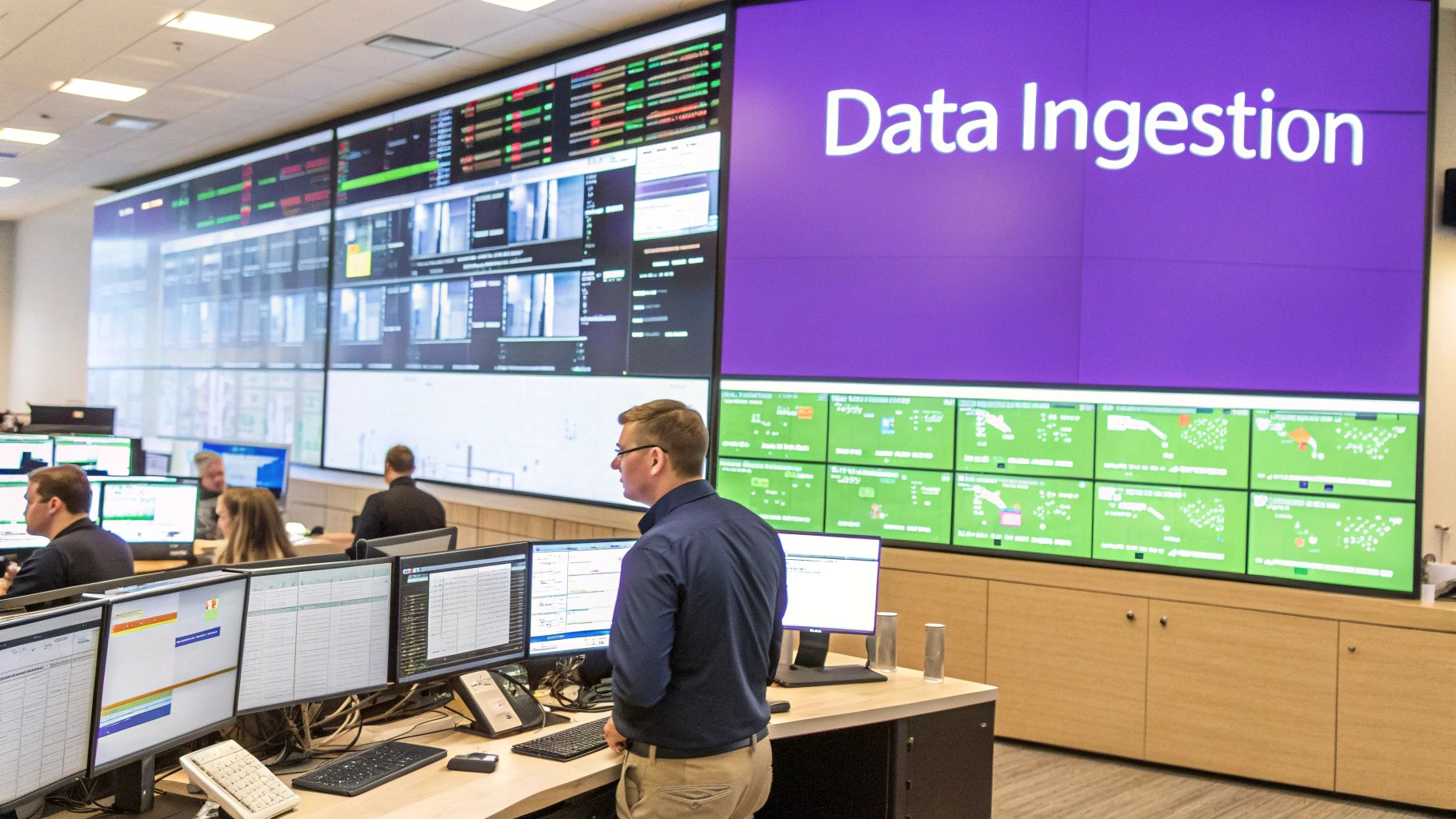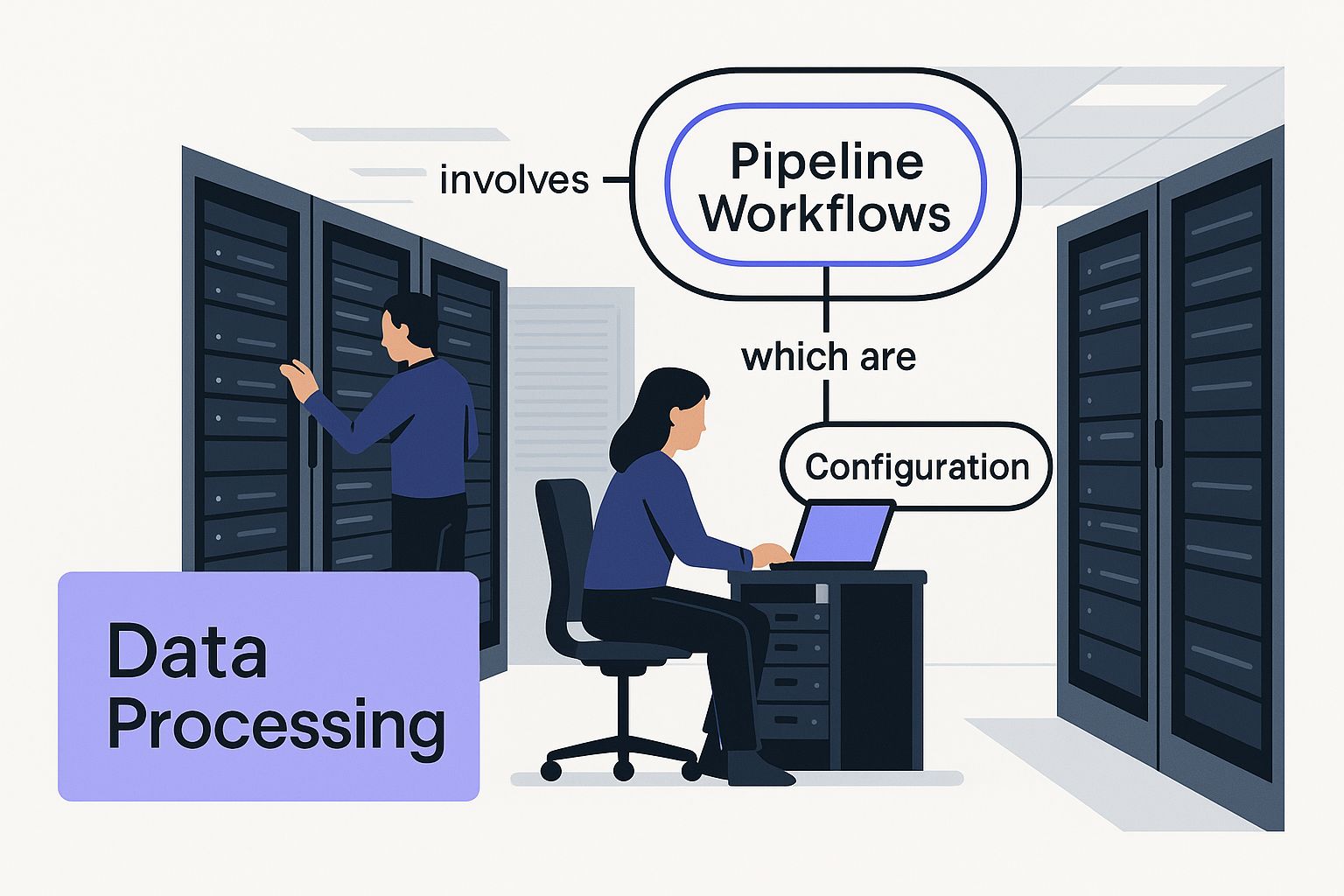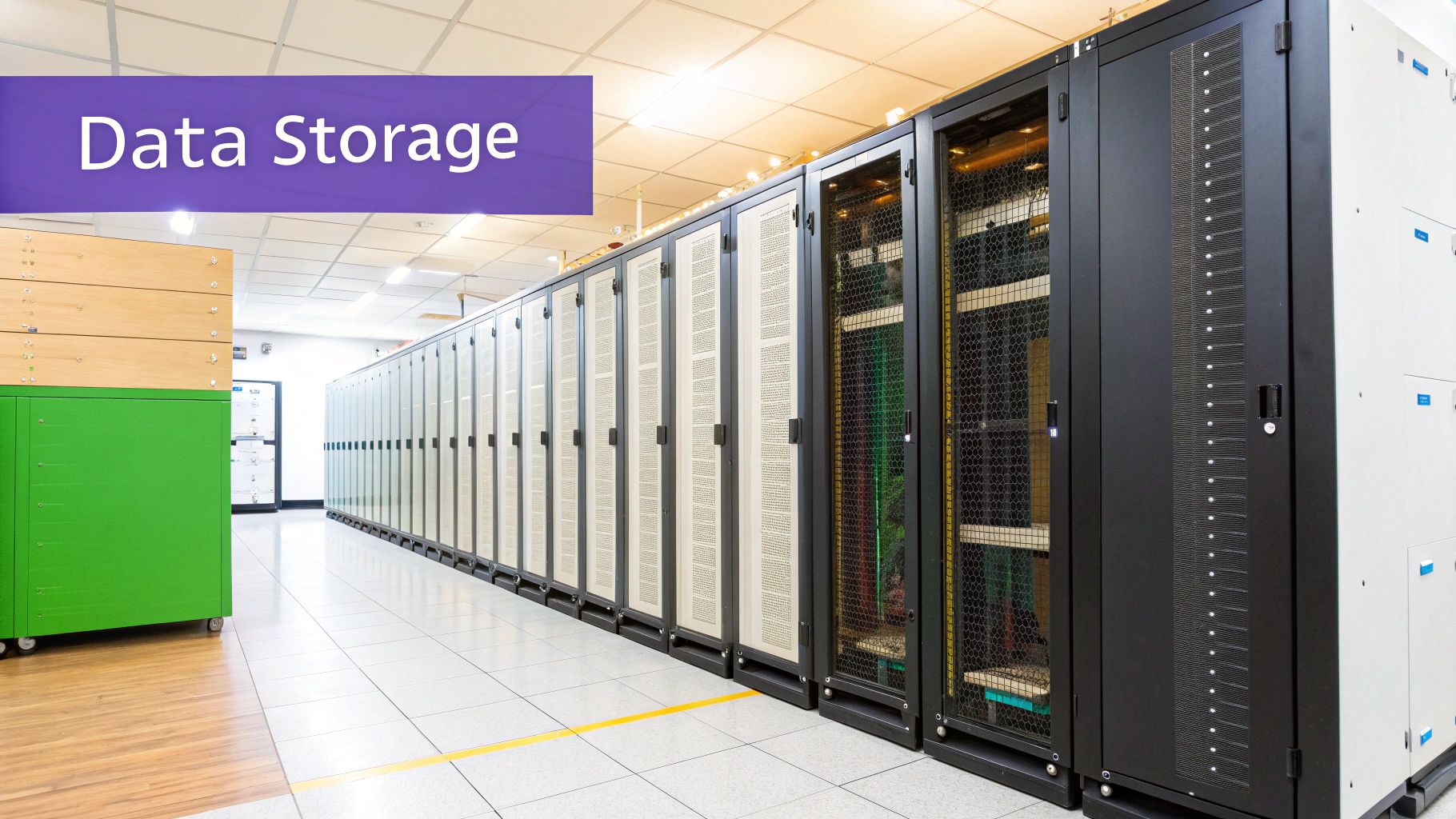
At its core, data pipeline architecture is the master plan for moving raw information from all its different origins to a final destination where it can actually be used. Think of it like a sophisticated city water system. It doesn't just dump reservoir water into your home; it collects, purifies, and reliably delivers clean, usable water right to your tap. In the same way, this architecture ensures data is gathered, cleaned up, and delivered efficiently for analysis.

A well-designed data pipeline architecture is the real engine behind modern analytics, business intelligence, and especially AI-driven platforms like Statisfy. It's not just one tool, but a whole ecosystem of connected processes working in concert. The ultimate goal is simple: make sure the data is timely, trustworthy, and ready for action the moment it arrives.
This structure carves out a clear, repeatable path for every piece of data. Without it, you’d have a data free-for-all—a chaotic mess where information is scattered, inconsistent, and nearly impossible to find. A solid architecture tames that chaos and creates a "single source of truth" that everyone from marketing to product development can count on.
Every data pipeline, no matter how complex, is built on a few fundamental stages. These steps map out the journey data takes from its raw, jumbled state to its final, analytics-ready form.
The table below breaks down these core stages to give you a clearer picture of what's happening under the hood.
Ultimately, these stages work together to create a reliable flow that turns messy, raw data into clear, strategic insights.
The idea of "pipelining" data isn't some brand-new concept born in the cloud era. It actually has deep roots in early computing and hardware design. For instance, companies were using internal data pipeline architectures in digital signal processing products way back in the 1990s. This journey from hardware-centric systems to today's cloud models shows just how enduring the core principles of data flow are.
Of course, today’s architectures are a world away from those early designs, now built to handle the staggering volume and variety of data our applications produce. Modern pipelines are designed for:
To draw a parallel, the automation and logic that drive a data pipeline have a lot in common with the world of software development. To see how these automation principles work in another context, it’s helpful to understand what a CI/CD pipeline is. Both are about creating an automated, repeatable, and reliable process for delivering a valuable end product—whether it's code or data.
To really get a handle on data pipeline architecture, you first need to know what it’s made of. Every solid pipeline, no matter its job, is built on four core pillars. They all work together to take raw information and turn it into something genuinely valuable for the business.
Think of it like a modern recycling plant. Raw materials get dropped off, and a systematic process transforms them into useful new products.
Each stage in this data journey has a specific, critical role. If even one part is designed poorly or breaks down, the whole system can grind to a halt. That leads to lost data, bad insights, and, ultimately, poor business decisions. Let's break down these four pillars to see how they come together to create a reliable data engine.

This image of technicians working on complex workflows really drives home the point. It shows that every piece of the puzzle, from pulling in the data to storing it, needs careful attention to keep information flowing smoothly.
Data ingestion is where it all begins. It's simply the act of collecting raw data from all your different sources and pulling it into one central system.
Sticking with our recycling plant analogy, ingestion is the fleet of trucks fanning out across the city. One truck is designated for glass, another for paper, and a third for plastic, and they all collect from different neighborhoods. In the data world, these "neighborhoods" are your data sources, and they can be incredibly diverse.
You might be pulling data from places like:
The ingestion layer has to be flexible. It needs to connect to all these sources, handle a mishmash of formats (like JSON, CSV, or flat files), and pull in data either in scheduled batches (say, once a day) or as a continuous, real-time stream.
Once all that raw material arrives at the plant, it’s not ready to be used. This is where processing comes in. This stage is all about cleaning, standardizing, and transforming that raw data into a clean, consistent, and usable format.
This is the main sorting and refining facility in our recycling plant. It's where workers and machines sort the jumbled materials, wash containers, shred paper, and melt down plastics. The goal is to get the raw materials ready for their next life.
A pipeline's processing stage is where the real value is unlocked. It turns messy, unreliable data into a trustworthy asset the whole company can rely on for making big decisions. Without this step, you're just hoarding junk.
For example, an AI-driven customer success platform like Statisfy would run a series of processing jobs to get customer data ready for its churn prediction models.
Common Processing Tasks
The choice between ETL (Extract, Transform, Load) and ELT (Extract, Load, Transform) directly shapes this stage. ETL transforms data before it hits your storage, while ELT loads the raw data first and transforms it later—a more flexible approach for today's diverse analytics needs.
After all that cleaning and refining, the data needs a safe and organized place to live. The storage layer is a durable, secure, and scalable repository where prepared data is kept, ready for analysis.
In our analogy, this is the well-organized warehouse where the processed goods—bales of clean paper, pellets of plastic—are neatly stacked and cataloged. This setup makes it easy for buyers to find and grab exactly what they need, when they need it.
In a modern data pipeline architecture, you'll typically find two main types of storage systems:
Today, many companies blend the two, creating a "data lakehouse" that gives you the flexibility of a data lake with the robust management features of a data warehouse.
Finally, something has to manage this entire, end-to-end workflow. Data orchestration is the brain of the operation, responsible for scheduling, automating, and monitoring the pipeline to make sure every task runs in the right order, on time, and without any errors.
The orchestrator is our plant manager. They're the one scheduling truck routes (ingestion), overseeing the sorting lines (processing), and managing inventory in the warehouse (storage). They’re also the one who deals with any problems that pop up, like a machine breakdown or a delayed shipment.
Tools like Apache Airflow or Prefect act as these digital plant managers. They let engineers define entire workflows as code, set dependencies between tasks, schedule jobs to run automatically, and send alerts when something goes wrong. Without good orchestration, a data pipeline architecture is just a bunch of disconnected scripts—fragile, prone to failure, and nearly impossible to manage at scale.

When it comes to data pipelines, there's no such thing as "one size fits all." Your architecture needs to be shaped by your specific business goals, especially how quickly you need answers from your data. You wouldn’t enter a speedboat in a cargo ship race, and the same logic applies here—you have to match the design pattern to the job at hand.
Most modern data systems are built on one of three foundational patterns. Getting a real feel for how each one works, including their trade-offs, is the key to building a pipeline that's not just functional, but genuinely effective. Let's dig into these common approaches.
The classic, time-tested approach is batch processing. The best way to think about it is like a restaurant cashing out at the end of the night. Instead of running to the bank after every single transaction, they collect all the day's earnings and make one large, consolidated deposit.
That’s exactly how batch processing operates. It gathers data over a specific period—maybe an hour, a day, or even a week—and processes it all at once in a scheduled "batch." It’s the perfect fit for large-scale, non-urgent tasks where having data that's up-to-the-second isn't critical.
This pattern is a favorite for a few good reasons:
A marketing team analyzing monthly campaign performance, for instance, has no need for real-time updates. A single daily or weekly job to calculate ROI and customer acquisition costs does the job perfectly.
On the opposite end of the spectrum is streaming processing, which tackles data the moment it’s created. This isn’t a nightly deposit; it’s a live stock market ticker. Data is processed event by event, in near real-time, often within a few milliseconds or seconds of generation.
This pattern becomes absolutely essential when you need to act now. A delay of just a few minutes could mean a lost sale or a critical system failure that could have been prevented. For any use case where latency is the enemy, a streaming architecture is your answer.
When your business needs to react the moment something happens, streaming isn't a luxury—it's a necessity. It’s the architectural choice that powers instant fraud alerts, dynamic pricing, and real-time operational monitoring.
Think about our own AI platform, Statisfy. To flag a key customer who is showing signs of frustration—like repeatedly failing to use a new feature—we have to analyze their behavior as it happens. If we waited for a nightly report, the customer would already be long gone.
So, what do you do when you need the rock-solid historical accuracy of batch processing and the immediate insights of streaming? That’s where hybrid models come into the picture. The Lambda architecture was designed specifically to solve this problem.
It elegantly handles this by running two parallel data lanes:
When you ask for data, the system cleverly merges results from both layers to give you a complete picture. It's incredibly powerful, but its biggest downside is complexity. You're essentially building and maintaining two separate data systems.
This complexity is what inspired the Kappa architecture, a much leaner alternative. Kappa’s goal is to do everything—real-time queries and historical analysis—with a single streaming pipeline. It does this by simply "replaying" the stream of data when it needs to do historical recalculations, completely getting rid of the batch layer. It's a cleaner approach that’s quickly gaining traction, but it hinges on having a very robust and scalable streaming platform.
To make sense of it all, here is a direct comparison of the three main architecture patterns. This should help you choose the right approach based on your specific use case, data velocity, and latency requirements.
Ultimately, choosing the right pattern comes down to a deep understanding of your business needs. By weighing the pros and cons of throughput, cost, and complexity, you can design a data pipeline that truly supports your goals.
A brilliant data pipeline architecture is only as good as the tools you use to build it. When you first step into the world of the modern data stack, it can feel like walking into a massive, bustling workshop. There are countless specialized tools, each designed for a specific job. Knowing which one to grab—and when—is the key to building a system that actually works.
This isn't about finding a single "best" tool. It’s about assembling a cohesive toolkit where every component works well with the others. The goal is to create a seamless path from raw data to valuable insight, using technologies that fit your team's skills, budget, and the problems you're trying to solve.
Let’s break down the essential tools for each stage of your pipeline.
The first hurdle is always the same: getting data out of its source and into your system. Ingestion tools are the specialized connectors and adapters that make this happen reliably. They're built to pull data from a huge range of sources—from SaaS APIs like Salesforce to transactional databases like PostgreSQL—and load it all into one central place.
Two big names really stand out here:
The choice often boils down to a classic trade-off: Fivetran’s plug-and-play ease versus Airbyte’s customizability and open-source freedom.
Once your data is loaded, it's almost never ready to use. This is where processing and transformation tools come in. Think of them as the workbenches where you clean, model, and prepare your data for analysis. This is the step where raw information gets shaped into a genuinely valuable asset.
The modern standard for this is dbt (data build tool). It has completely changed how teams handle transformation by letting analysts build complex data models using nothing more than simple SQL. It brings software engineering best practices—like version control, testing, and documentation—right into the analytics workflow.
For more complex, large-scale jobs, especially with streaming data, Apache Spark is still a powerhouse. It’s a powerful distributed computing engine that can chew through massive datasets with incredible speed, but it definitely comes with a steeper learning curve.
Your processed data needs a home, and modern cloud data platforms provide powerful, scalable options for storing it. These aren't just simple databases anymore; they are sophisticated analytical engines designed for lightning-fast queries on huge datasets.
The rise of cloud data platforms has been a game-changer. It has democratized access to enterprise-grade data infrastructure, allowing teams of any size to build a powerful data pipeline architecture without massive upfront investment.
The three major cloud providers offer compelling solutions:
Finally, a pile of tools isn't a pipeline until something tells them when to run and in what order. Orchestration tools are the conductors of your data symphony. They manage dependencies, schedule jobs, and handle things when they inevitably go wrong.
Apache Airflow has long been the open-source standard, loved for its flexibility and robust Python-based workflows. More recently, tools like Dagster and Prefect have emerged, offering more modern user interfaces and a better developer experience, especially when it comes to data-aware scheduling and seeing what's happening under the hood.
The explosive growth of these tools reflects a booming market. The data pipeline tools market was valued at $11.24 billion in 2024 and is projected to hit $29.63 billion by 2029. This rapid expansion is driven by the urgent need for agile, high-quality data systems. You can explore more about these market trends in the full research from ResearchAndMarkets.com.
Beyond the specific data pipeline tools, remember to think about the foundation. Automating your underlying systems with infrastructure automation tools can streamline deployment and management, forming a crucial part of your modern data stack. By carefully selecting tools for each layer, you build a cohesive and resilient data pipeline architecture that turns your data into a true strategic advantage.
A great data pipeline is more than just a collection of fancy tools and design patterns. It's built on a foundation of solid principles that ensure your data is reliable, secure, and ready for whatever the business needs next. Without these practices, even the most sophisticated pipeline can quickly become a fragile, high-maintenance mess.
Following these best practices is what separates a brittle system that constantly breaks from a resilient, automated data engine that just works. Let's walk through the essentials that make a pipeline truly robust, using some real-world scenarios to show why each one is so critical.
Imagine one of your key data sources, an external API, suddenly changes a field format without telling you. It's a small change, but without any safeguards, this error could silently corrupt your data for weeks. By the time anyone notices, you've got flawed reports and stakeholders who no longer trust the numbers. This is precisely why data quality checks are your first line of defense.
Automated data validation shouldn't be an afterthought; it needs to be baked directly into your pipeline at every stage.
customer_id field should never be null, and a revenue field must always be a positive number. No exceptions.By embedding these checks, you create a pipeline that actively prevents the "garbage in, garbage out" problem. It's how you make sure every decision is based on data you can actually trust.
So, your latest marketing campaign was a massive success, and your user base doubled overnight. Fantastic! But what happens to your data pipeline? If it wasn't built to scale, it's now a major bottleneck. Processing jobs that took minutes now take hours, and your cloud costs are spiraling. This is why you have to design for scalability from day one.
This means making smart architectural choices right from the start.
A scalable pipeline isn’t about throwing money at oversized servers for a future you might have. It’s about creating a flexible, modular design that can grow efficiently as demand increases, all without sacrificing performance.
For example, using cloud-native platforms like Snowflake or Databricks lets you scale horizontally, adding more compute power only when you need it. It also helps to break your pipeline into independent, modular services. That way, you can scale one overloaded component without having to re-engineer the entire system. And don't forget performance tuning—caching frequently used data and optimizing your processing jobs are key to keeping things snappy and managing costs.
Here’s a classic nightmare scenario: a critical pipeline job fails silently at 2 AM. Nobody has a clue until the executive team logs on the next morning to see a dashboard full of stale, outdated data. This is where proactive monitoring and alerting save the day. You should always know there's a problem long before your users do.
A solid monitoring strategy gives you a real-time health check on your entire pipeline. You should be tracking key metrics like:
When any of these metrics cross a dangerous threshold, an automated alert should fire off immediately to the right people. This transforms your data team from reactive firefighters into proactive problem-solvers, ensuring your pipelines stay up and running. Of course, implementing robust cloud data protection strategies is another cornerstone here, protecting your data from both corruption and outside threats.
Theory is great, but let's be honest—it’s seeing a data pipeline architecture in the wild that really makes these concepts stick. So, let's walk through a real-world scenario. Imagine we're building the data engine for an AI-powered customer success platform, which we’ll call Statisfy. Its main job? To spot at-risk customers before they even think about leaving and give the team the insights needed to prevent churn.
This whole operation lives or dies by its data pipeline. It’s what turns a messy jumble of customer interactions into clean, predictive intelligence. The business value here is obvious: keep more customers, make more money. This example pulls together all the components we've talked about to show how they drive smart business decisions.
Everything starts with ingestion. To get that complete, 360-degree view of a customer, Statisfy has to pull data from all over the place. Think of it like connecting a bunch of different streams into one big river. The pipeline connects to:
Next up is the processing stage. Let's face it, raw data is a disaster. It's inconsistent, full of duplicates, and just plain messy. Here, the pipeline runs a series of transformation jobs to clean everything up. Timestamps get converted to UTC, duplicate records are zapped, and all that separate data is stitched together using a unique customer ID. The real magic, though, is feature engineering. This is where raw events are turned into meaningful metrics for the AI model, like "time since last login" or "number of support tickets this month."
A well-designed data pipeline isn't just a technical achievement; it's the central nervous system of a data-driven company. It ensures that valuable signals from customers are not just collected but are heard, understood, and acted upon.
Once the data is refined, it's loaded into storage—typically a cloud data warehouse. This becomes the single source of truth for everyone. Customer Success Managers can jump in and run reports directly, while data scientists use this clean dataset to train and retrain their churn prediction models.
Finally, orchestration is the glue that holds it all together. A workflow tool automatically schedules the ingestion and processing jobs to run every night. If something breaks, it immediately sends an alert to the data team. This automation is what makes the whole data pipeline architecture sustainable and scalable as the business grows.
It’s this kind of sophisticated data handling that explains why the global data pipeline market is projected to soar from $12.26 billion in 2025 to $43.61 billion by 2032. This explosive growth reflects a massive, worldwide push for better analytics and cloud integration. You can learn more about the global market growth for data pipelines and see just how critical these systems have become.
When you're in the trenches building a data pipeline architecture, a lot of practical questions pop up. Let's tackle some of the most common ones I hear, giving you clear answers and a solid place to start.
The simplest way to think about it is when you do the cleanup work.
With traditional ETL (Extract, Transform, Load), you clean and shape your data before it ever touches your central data warehouse. This was the go-to method for years when data was structured and predictable. Think of it like a chef prepping all ingredients perfectly before they go into the pot.
Modern ELT (Extract, Load, Transform) completely flips that around. You dump all the raw data—messy or not—directly into a powerful cloud data warehouse or lakehouse first. The transformation happens afterward, right inside the warehouse. This gives you way more flexibility to work with all kinds of data and run different kinds of analysis on the same raw source. It's like throwing all your groceries in the pantry and deciding what meal to cook later.
Staring at a blank canvas can be intimidating, but you don't need to build a masterpiece on day one. Start small and get a win.
A solid data pipeline is the absolute backbone of any machine learning model that actually works in the real world. It's the circulatory system that feeds your models clean, reliable, and fresh data for both initial training and ongoing predictions.
For machine learning, a pipeline is much more than a data mover. It's what makes the whole system operational. It handles everything from engineering the features your model needs and validating the data quality to automatically retraining the model. This ensures your AI doesn't start making bad decisions based on stale or corrupt information. This whole practice has a name: MLOps (Machine Learning Operations).
Ready to see how a powerful data pipeline can truly change your customer success game? Statisfy uses an AI-driven architecture to turn your raw customer data into proactive insights that stop churn before it starts and help you find new revenue. Discover how Statisfy can automate your success.